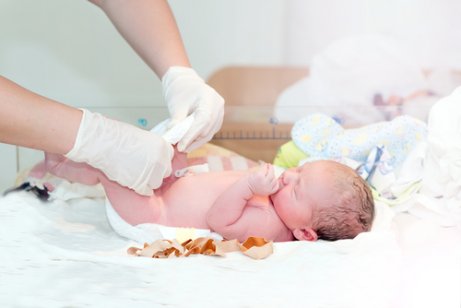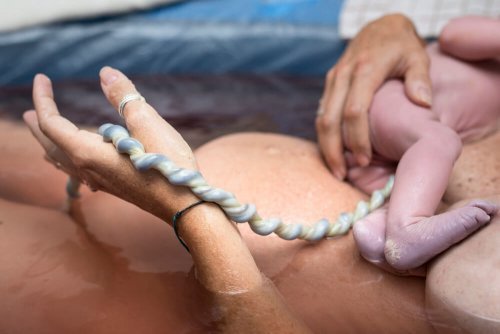How to Take Care of Your Newborn's Umbilical Cord Stump

How should parents care for their little one’s umbilical cord stump? The umbilical cord is the via through which babies feed while they’re developing inside their mother’s womb.
Once babies are born, they no longer need their umbilical cords. Therefore, doctors cut the cord, leaving behind a sort of stump, sealed off with a small clamp so that it doesn’t bleed.
This annex to a newborn baby’s body will remain connected to the belly button for up to 2 or 3 weeks. Once it falls off, the area will still need 3 or 4 more days to heal.
In the meantime, parents should be sure to care for their baby’s umbilical cord and belly button through proper hygiene.
However, this is one of the issues that raises uncertainty and fear, especially for first-time parents. To help dispel any doubts you may be experiencing, we want to offer some advice that will guide you in this process.
How to care for a newborn’s umbilical cord stump
The umbilical cord is a vital organ in the gestation of babies. To keep the organ healthy, parents must take the following into consideration:
Bathing your baby before the umbilical cord stump falls off
One of the most common questions that parents ask is how to handle bathing their newborn before the stump falls off. It’s important to point out that, in order for the stump to remain healthy and fall off properly, it must remain dry.
Therefore, parents shouldn’t bathe their babies, as this may delay the process even further. Rather, you can wash your little one with a sponge and warm water. Remember not to take too long, since your newborn can easily become cold while damp and undressed.
What products should parents use to care for their baby’s umbilical cord stump?
Many point out the importance of cleaning the area with 70% isopropyl alcohol, which isn’t the same as normal alcohol. Parents should apply this alcohol with gauze, and never with cotton, as cotton may leave behind loose fibers.
The cleaning procedure consists of simply wetting the gauze with alcohol and wrapping the stump with the gauze. An alternative to alcohol is clorhexadine. However, parents should not use iodine-based products.

Is it safe to wash the area with just water?
Yes, in fact, this is even better than washing the stump with alcohol. Water is just as effective in maintaining proper hygiene in the area. Of course, water should be applied in moderation to avoid excess humidity, which can delay the drying process.
What about my baby’s clothing?
In warmer days, it’s best to leave your baby in just his or her diaper and a soft, light cotton shirt on top. This way, you favor airflow and aid in the drying of your baby’s cord stump.
While the cord stump is still attached, it’s best to avoid one-piece suits. At the same time, when you put your baby’s diaper on, make sure to leave the belly button stump uncovered.
“Once the umbilical cord stump falls off, the area will still need 3 or 4 more days to heal.”
Is it okay to remove the stump if it’s about to fall off?
No, this isn’t recommended. Even if the stump is hanging on by a hair, it’s best to wait and allow for it to fall off on its own.
Once the stump has fallen off, you should continue cleaning the area just as you’ve been doing. Once everything is dry and healed, then you can discontinue treatment.
Possible signs of infection

Lastly, it’s important to clarify that you shouldn’t worry if you see a bit of blood or yellowy liquid after the cord falls off. This is normal.
However, you should practice proper precaution and check with a pediatrician if you notice any of the following symptoms:
- Reddening of the skin around the stump.
- Seeping of blood or yellowing liquid from the cord of the belly button. It’s important to differentiate between normal bleeding, and considerable bleeding which may be the result of rubbing against the diaper.
- If the cord smells bad.
- Your baby has a fever.
- If pink scar tissue – glanuloma – forms around the area and doesn’t go away within a week.
Finally, you should also pay attention to abnormalities in regards to your baby’s feeding, resting and behavior in general. And, besides the above suggestions, parents should also be sure to follow all of the indications given by their baby’s pediatrician.
How should parents care for their little one’s umbilical cord stump? The umbilical cord is the via through which babies feed while they’re developing inside their mother’s womb.
Once babies are born, they no longer need their umbilical cords. Therefore, doctors cut the cord, leaving behind a sort of stump, sealed off with a small clamp so that it doesn’t bleed.
This annex to a newborn baby’s body will remain connected to the belly button for up to 2 or 3 weeks. Once it falls off, the area will still need 3 or 4 more days to heal.
In the meantime, parents should be sure to care for their baby’s umbilical cord and belly button through proper hygiene.
However, this is one of the issues that raises uncertainty and fear, especially for first-time parents. To help dispel any doubts you may be experiencing, we want to offer some advice that will guide you in this process.
How to care for a newborn’s umbilical cord stump
The umbilical cord is a vital organ in the gestation of babies. To keep the organ healthy, parents must take the following into consideration:
Bathing your baby before the umbilical cord stump falls off
One of the most common questions that parents ask is how to handle bathing their newborn before the stump falls off. It’s important to point out that, in order for the stump to remain healthy and fall off properly, it must remain dry.
Therefore, parents shouldn’t bathe their babies, as this may delay the process even further. Rather, you can wash your little one with a sponge and warm water. Remember not to take too long, since your newborn can easily become cold while damp and undressed.
What products should parents use to care for their baby’s umbilical cord stump?
Many point out the importance of cleaning the area with 70% isopropyl alcohol, which isn’t the same as normal alcohol. Parents should apply this alcohol with gauze, and never with cotton, as cotton may leave behind loose fibers.
The cleaning procedure consists of simply wetting the gauze with alcohol and wrapping the stump with the gauze. An alternative to alcohol is clorhexadine. However, parents should not use iodine-based products.

Is it safe to wash the area with just water?
Yes, in fact, this is even better than washing the stump with alcohol. Water is just as effective in maintaining proper hygiene in the area. Of course, water should be applied in moderation to avoid excess humidity, which can delay the drying process.
What about my baby’s clothing?
In warmer days, it’s best to leave your baby in just his or her diaper and a soft, light cotton shirt on top. This way, you favor airflow and aid in the drying of your baby’s cord stump.
While the cord stump is still attached, it’s best to avoid one-piece suits. At the same time, when you put your baby’s diaper on, make sure to leave the belly button stump uncovered.
“Once the umbilical cord stump falls off, the area will still need 3 or 4 more days to heal.”
Is it okay to remove the stump if it’s about to fall off?
No, this isn’t recommended. Even if the stump is hanging on by a hair, it’s best to wait and allow for it to fall off on its own.
Once the stump has fallen off, you should continue cleaning the area just as you’ve been doing. Once everything is dry and healed, then you can discontinue treatment.
Possible signs of infection

Lastly, it’s important to clarify that you shouldn’t worry if you see a bit of blood or yellowy liquid after the cord falls off. This is normal.
However, you should practice proper precaution and check with a pediatrician if you notice any of the following symptoms:
- Reddening of the skin around the stump.
- Seeping of blood or yellowing liquid from the cord of the belly button. It’s important to differentiate between normal bleeding, and considerable bleeding which may be the result of rubbing against the diaper.
- If the cord smells bad.
- Your baby has a fever.
- If pink scar tissue – glanuloma – forms around the area and doesn’t go away within a week.
Finally, you should also pay attention to abnormalities in regards to your baby’s feeding, resting and behavior in general. And, besides the above suggestions, parents should also be sure to follow all of the indications given by their baby’s pediatrician.
All cited sources were thoroughly reviewed by our team to ensure their quality, reliability, currency, and validity. The bibliography of this article was considered reliable and of academic or scientific accuracy.
- Díaz Gutiérrez, M. (2016). Cuidados del cordón umbilical en el recién nacido: revisión de la evidencia científica. Ars Pharmaceutica (Internet), 57(1), 5-10. http://scielo.isciii.es/pdf/ars/v57n1/revision1.pdf
- Doménech, E., González, N., & Rodríguez-Alarcón, J. (2008). Cuidados generales del recién nacido sano. Madrid: Asociación Española de Pediatría. https://www.seneo.es/Portals/0/Articulos/2.pdf
- Noguera Ortiz, N. Y., & Rodríguez Rodríguez, M. R. (2008). Aprendiendo a cuidar al recién nacido: un cuidado congruente con la cultura. Avances en Enfermería; Vol. 26, núm. 1; 103-111 23460261 01214500. http://www.bdigital.unal.edu.co/17273/
- Peinado-Jaén R. (2014). Cuidados del Cordón Umbilical: Revisión de la evidencia. (2014).
- Sánchez Luna M, Pallás Alonso CR, Botet Mussons F, Echá-niz Urcelay I, Castro Conde JR, Narbona E. (2009). Recomendaciones para el cuidado y atención del recién nacido sano en el parto y en las primeras horas después del nacimiento. An. Pediatría. 2009;71:349–361
This text is provided for informational purposes only and does not replace consultation with a professional. If in doubt, consult your specialist.








